Ready, Vette, Go: C4 ZR-1 and C5 Z06 bring bang for the buck
Metallic exhaust roar echoed through the hillside as I wound along Ohio’s Kokosing River. Overhead cams whirred and the engine swept through its sweet spot between 4500 and 6500 rpm. Shifting at redline, I was rewarded by another eager rush in the meat of the powerband. It’s hard to believe this is a big American V-8. Now, as in 1990, the Chevrolet Corvette ZR-1 is a revelation.
So revelatory, in fact, that it shocked General Motors’ own engine division into a frenzy of activity. GM engineers were so taken aback at the decision from on high to hire Lotus to design the ZR-1’s high-performance LT5 engine—and Mercury Marine for its construction—that they quickly got to work on new small-block V-8 designs. The result was in the car behind us, a 2004 Corvette Z06.
These two bygone bosses of Bowling Green obviously have a lot in common—flip-up headlamps, about 400 horses under their hoods, and capable handling. Here’s something else: Both can be had today in excellent condition for around $45,000, according to the latest Hagerty Price Guide. That’s quite a steal considering the recent run-up for other performance cars of the era (a roughly contemporary Toyota Supra Turbo, for instance, will easily run you six figures).
Of course, we couldn’t help but wonder which Vette is better. Father and son Hagerty members Rick and Rocky Yusi own pristine, low-mile examples of each and graciously shared them to help us understand what sets these cars apart. Together, we disappeared into the hills of southeast Ohio to find answers.
C4 ZR-1

Engaging with a C4 Corvette is an exercise in immersion. Or maybe it’s contortion. Slide over the famously large sill and slither down into the deeply bolstered bucket seat, and you’re completely enveloped by a high transmission tunnel and driver-oriented dash. You’re now of this Corvette, not merely in it.
Nowadays this cockpit—complete with orange-over-charcoal analog gauges, digital display, and acres of small buttons—screams RADwood. But in period, the futuristic design ethic was intended to break completely with prior generations of America’s sports car. “The C4 was a modern statement: It didn’t look back at heritage,” retired GM designer John Cafaro told me in a phone interview.

Brash as it is, there’s not much to the cabin or the design as a whole that tips off the casual observer that this version of the Corvette is a supercar slayer. “I love the way it looks and all the subtle ways it’s different from the base car, but I do wish Chevy made it stand out a bit more,” admitted Rick, who bought this ZR-1 new in 1990. The tachometer’s 7000-rpm redline is the only hint at the marvel that is under the clamshell hood.
The standard Corvette in 1990 had a pushrod, iron-block 5.7-liter L98 V-8 that produced 245 horsepower at 4000 rpm. The ZR-1’s engine, known as the LT5, carried over only the displacement and bore spacing. Its block and cylinder heads were aluminum. Dual overhead cams actuated 32 valves (versus 16 in the standard car). It made 375 horsepower at 5800 rpm—around the fuel cutoff for the standard car.
I fired up the LT5 and left the college-town charm of Wooster via a sweeping state route dotted with Amish farms. The bucket seat cosseted me with a vast array of power and pneumatic adjustments. Meanwhile, the three-way adjustable Selective Ride Control dampers—a feature that debuted on the ZR-1 and paved the way for similar tech in later models—impressively blunted road imperfections when set to Touring, the softest mode.
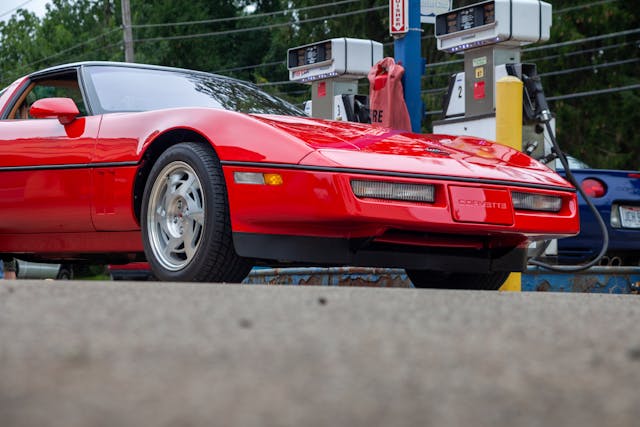
Along with that comfort, though, comes some softness in the controls. This is a car from a different era, after all. Initial application of the brake pedal is 1990s-GM squishy, although it firms up with increased pressure. The weighty, mechanical shifter atop the ZF six-speed box has a rubbery give as you reach each detent.
The asphalt roller coaster bends began south of Millersburg, where the scenery evolved from undulating corn and soy fields to rocky, rolling hills. I stiffened the ZR-1’s damper settings to Sport and then to Performance. Even in modern cars, selectable drive modes can be more gimmick than substance, but not here. The dampers deftly responded to imperfections and helped the car stay utterly poised as I pitched from left to right.

The harder you drive the ZR-1, though, the more it reveals the one dynamic trait that belies its age: the chassis itself. At anything more than about 6/10ths pace, the frame flexes through camber changes. The car never gets upset, but when pushed, the compliant chassis’ additional motion distracts from the experience. Turning the ride control setting from Performance down to Sport softens the dampers, enabling smoother, less wobbly transitions, yet I found myself wondering how much more dynamic the ZR-1 would feel had its structure been further stiffened to let that superb suspension more effectively do its job.
Despite that, I emerged from the twisty river-bottom roads with some newfound respect for the ZR-1. Remember: Less than a decade prior to this car’s debut, the Corvette was a still 190-hp weakling. This car made clear that Chevrolet wanted to build a world-class sports car, and the seriousness of that intention still shines through when you’re driving it today.
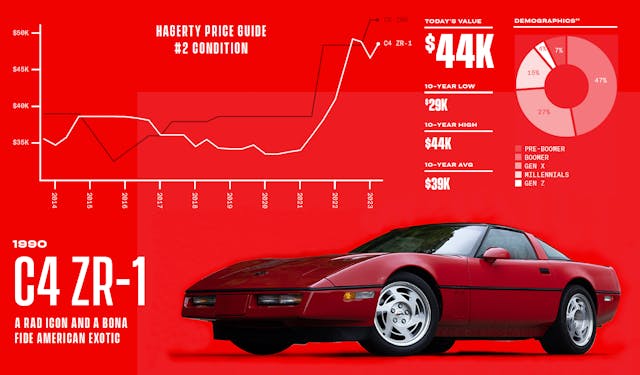
C5 Z06
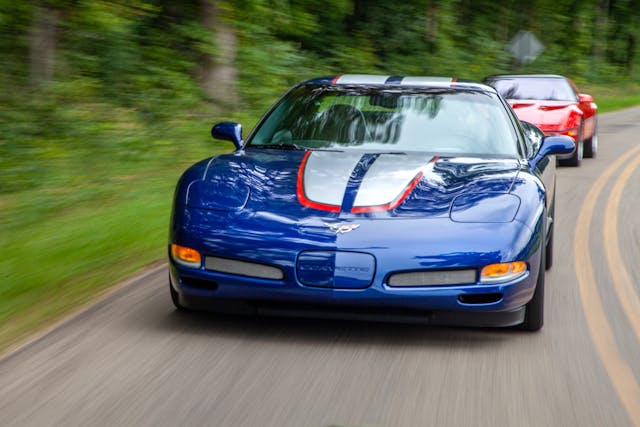
On to the Z06. The design is clearly less of a departure from what had come before than the C4. The General Motors that developed the C5 in the 1990s was more cautious—and had a considerably smaller pocketbook—than the one that had spawned the C4 in the early ’80s. Cafaro, who was chief designer for the C5, noted that special care had to be taken to appease various departments, including what he affectionately calls “the toothpaste and detergent folks” in marketing. “One little controversy could’ve killed the car,” he said. By 2004, the C5’s last year, Chevy had relaxed enough to allow a carbon-fiber hood and stripe package for the Commemorative Edition, as on the Yusis’ car. Today it’s worth slightly more than other C5 Z06s.
Styling aside, the generational difference from the ZR-1 immediately presented itself upon opening the door: Those massive side sills are gone. You can simply get into the car without first having to practice yoga.
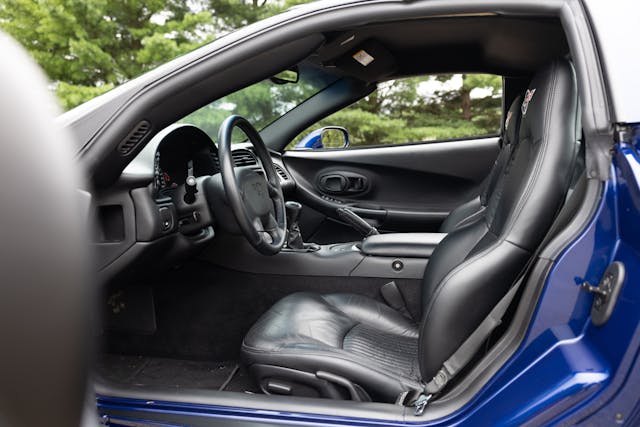
Those sills shrank because the C5’s chassis, four times stiffer, incorporated hydro-formed frame rails and a strengthened center tunnel. The concerted effort to increase rigidity went hand in hand with making the C5 accessible to a wider array of people. A longer wheelbase increased cabin space, as did repositioning the gas tanks to behind the seats.
Most of that practicality carried over to the high-performance Z06, which debuted in 2001. The Z06’s flat, wide seats surely did better in focus groups than the ZR-1’s, since they’re able to take in a broad swath of humanity, although they don’t hold you nearly as well in aggressive maneuvers. (Sport buckets, available in the base coupe and convertible, didn’t make it into the Z06 due to their extra weight.) Those same focus groups also nixed the pseudo-digital gauges, so you stare at more traditional analog gauges. As a result of the efforts to make the C5 more approachable, the Z06 feels more utilitarian and less of an occasion than the ZR-1.
At least, until you fire up the 405-horse, 5.7-liter V-8. The standard, lightweight titanium exhaust emitted a docile burble that turned raw and throaty when I rolled onto the throttle. The LS6, as this engine is known, is on its face less exotic than the ZR-1’s LT5: It’s a pushrod engine and makes only 55 horsepower more than the contemporary base Corvette. Yet that only speaks to how profoundly the tried-and-true small-block had changed in the intervening years. The LS-series V-8, which debuted with the C5 for 1997 and eventually proliferated to millions of trucks and SUVs (not to mention hot rods and restomods of all stripes), was the most significant update to GM’s bread-and-butter V-8 since it debuted in the 1950s. An aluminum block was baked in from the start, as were high-compression aluminum cylinder heads.
The LS6 was the first true rock star of this engine family, with even higher (10.5:1) compression, better-breathing intake manifold and cylinder heads, and myriad tweaks to the internals. The result is an engine that pulls linearly—and hard—from about 2000 rpm and barely lets up by its 6500-rpm red-line. You can rev it out or stick the gearbox in third or fourth and count on low-end torque to muscle through a corner.

The Z06’s controls would be at home in a current sports car. Moderately heavy steering offers feedback but isn’t particularly lively—for better and for worse, it’s similar to many modern racks. The shifter’s throws are long but crisper than in the ZR-1. The brakes inspire confidence with a firm and linear pedal. And, thanks to the relocation of the transmission to the rear of the car, the Z06’s footbox allows plenty of room for fancy pedal work.
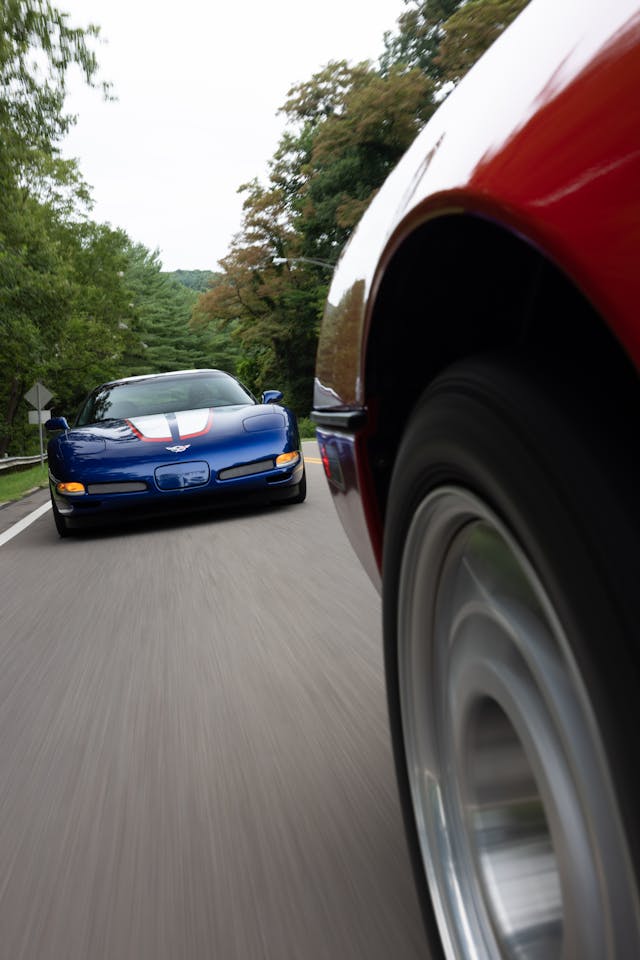
Returning to the route along the Kokosing, I discover how progressive and predictable the Z06 is, especially for something with this much brawn. The nonadjustable suspension allows for plenty of body roll in assertive driving, but it’s always well composed. You quickly get used to this trait, and it becomes part of how you set the car through a corner. The chassis does exhibit some flex, but it’s dramatically less than the ZR-1’s. Overall, the 3100-pound Z06 feels big but never unwieldy, even on tight, technical roads.
As the day ended, I slotted the Z06’s shifter into sixth gear and settled into a cruise. The car quietly soaked up the miles and nosed close to 30 mpg at the speed limit. It was almost funny; in contrast to the ZR-1, the only thing I needed to adjust to bring out the Z06’s differing personalities was what gear I was in.
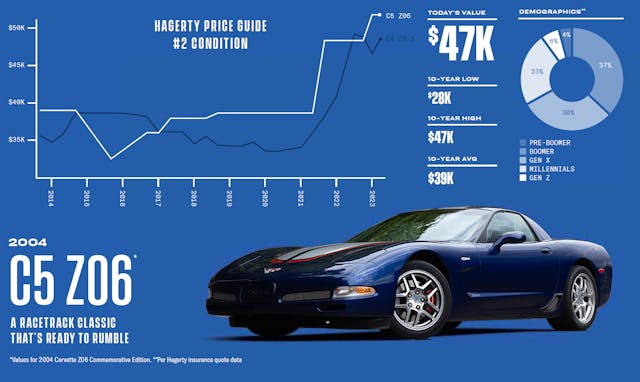
***

What we have here, despite the apparent similarities and comparable values, are two very different slices of apple pie. The ZR-1 is more complex and full of character. It is also, from a design and historical standpoint, more significant—we’re talking about the first Corvette in decades that truly went toe-to-toe with the best in the world. Perhaps for those reasons, trailer-queen ZR-1s tend to fetch considerably more than similarly pampered Z06s.
If you’re looking to drive a lot, it’s hard to argue with a Z06. Say what you will about GM’s obsession at the time with metrics and ergonomics; it yielded a sports car you can still easily use every day to fetch groceries—and then embarrass younger and more expensive cars at a weekend track day. It’s truly a Goldilocks car. That versatility and usability help explain why it’s generally appreciating faster than the ZR-1—and why we put it on our most recent Bull Market List.
Ultimately, both exude “Corvette” and offer heaps of performance and personality. I end the day still wondering which $45K classic I would choose, but more so, I’m grateful to have experienced them both.
***
This article first appeared in Hagerty Drivers Club magazine. Click here to subscribe and join the club.
Check out the Hagerty Media homepage so you don’t miss a single story, or better yet, bookmark it. To get our best stories delivered right to your inbox, subscribe to our newsletters.
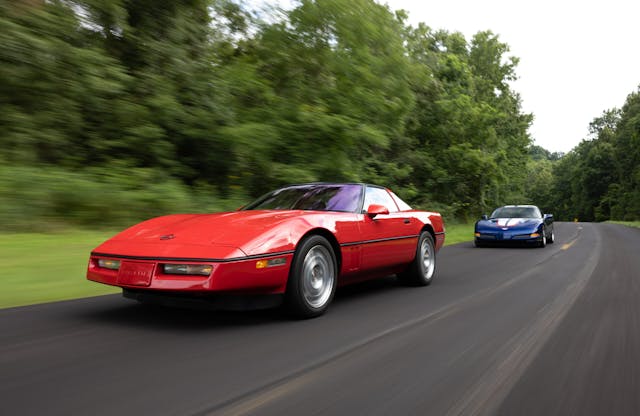
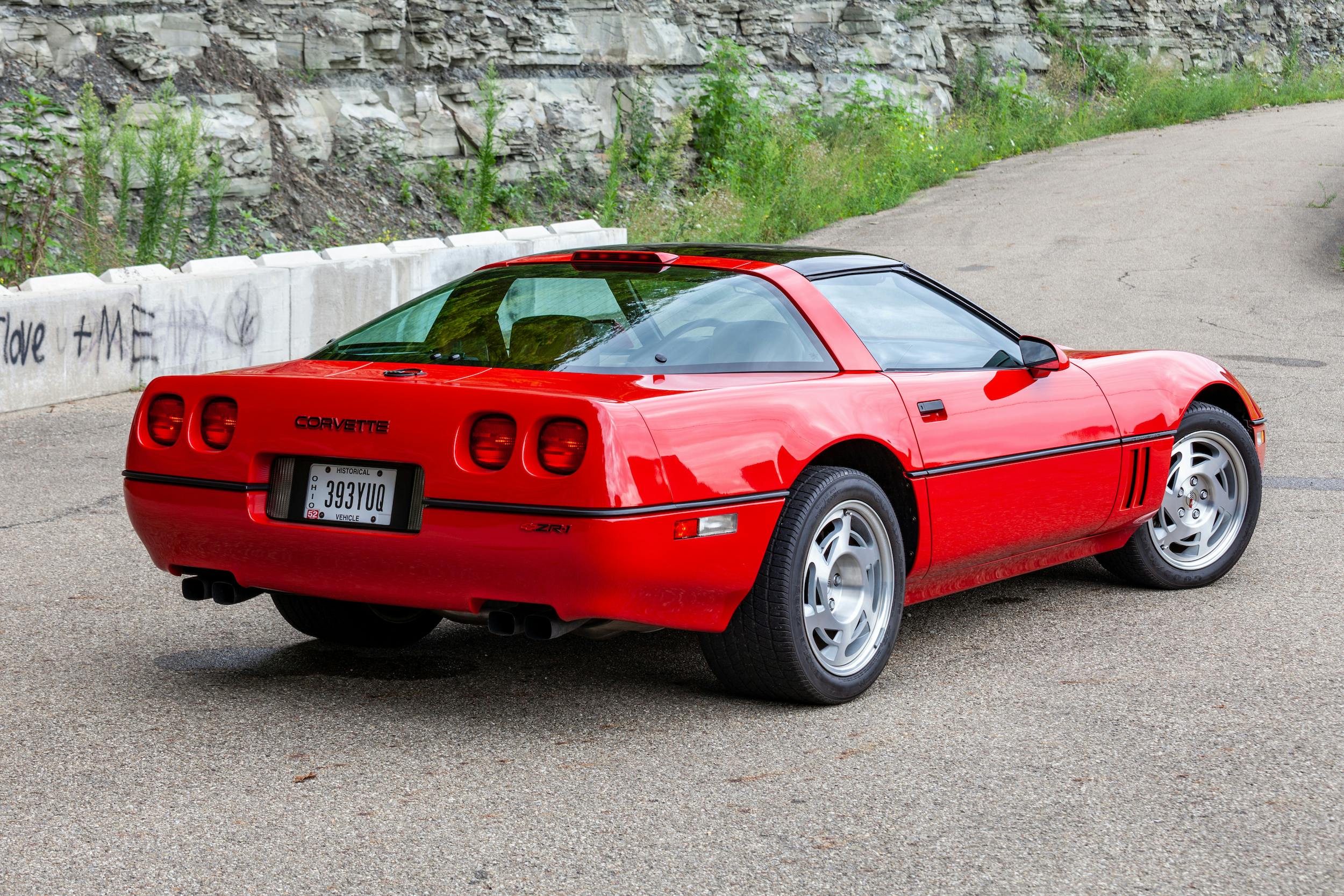
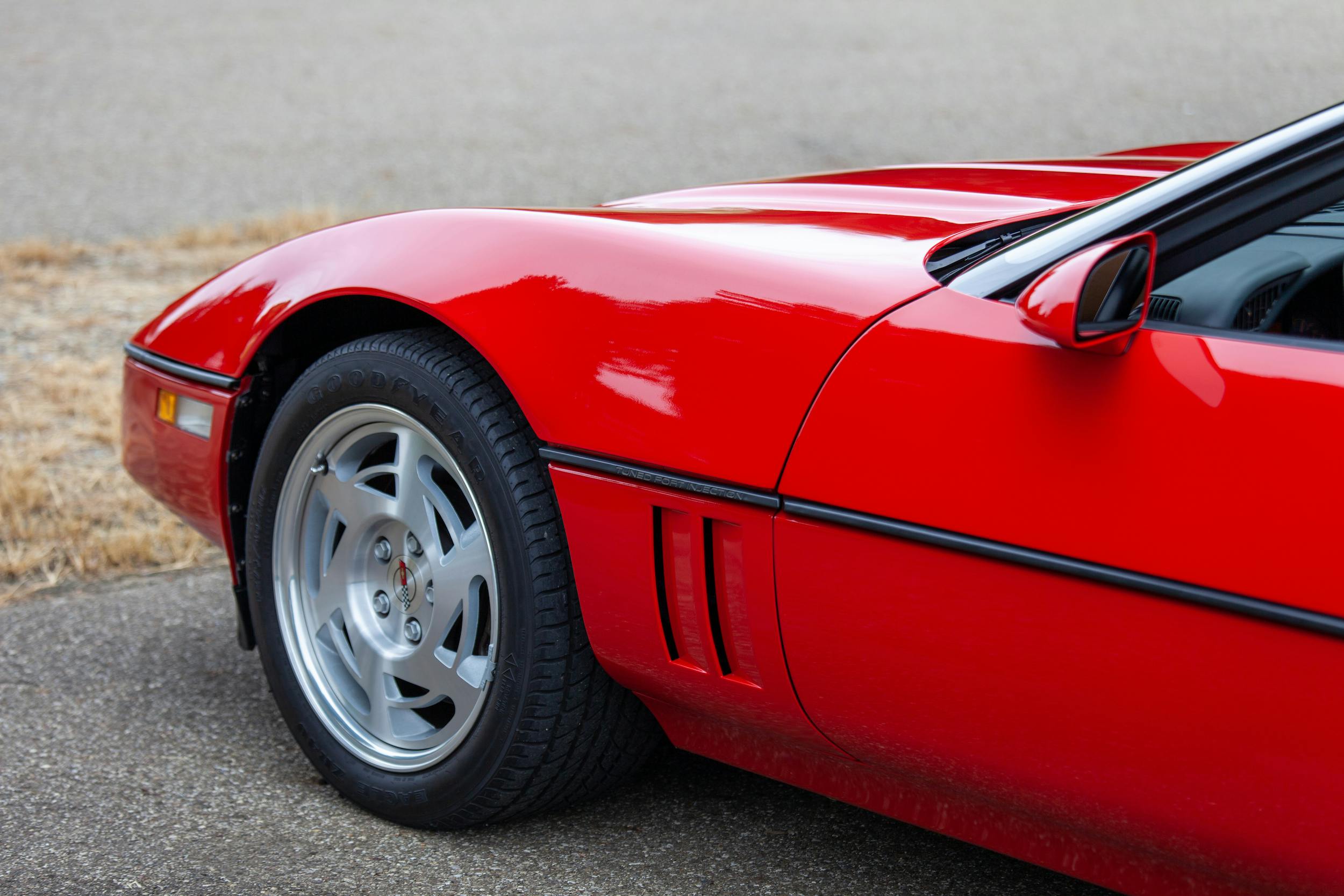
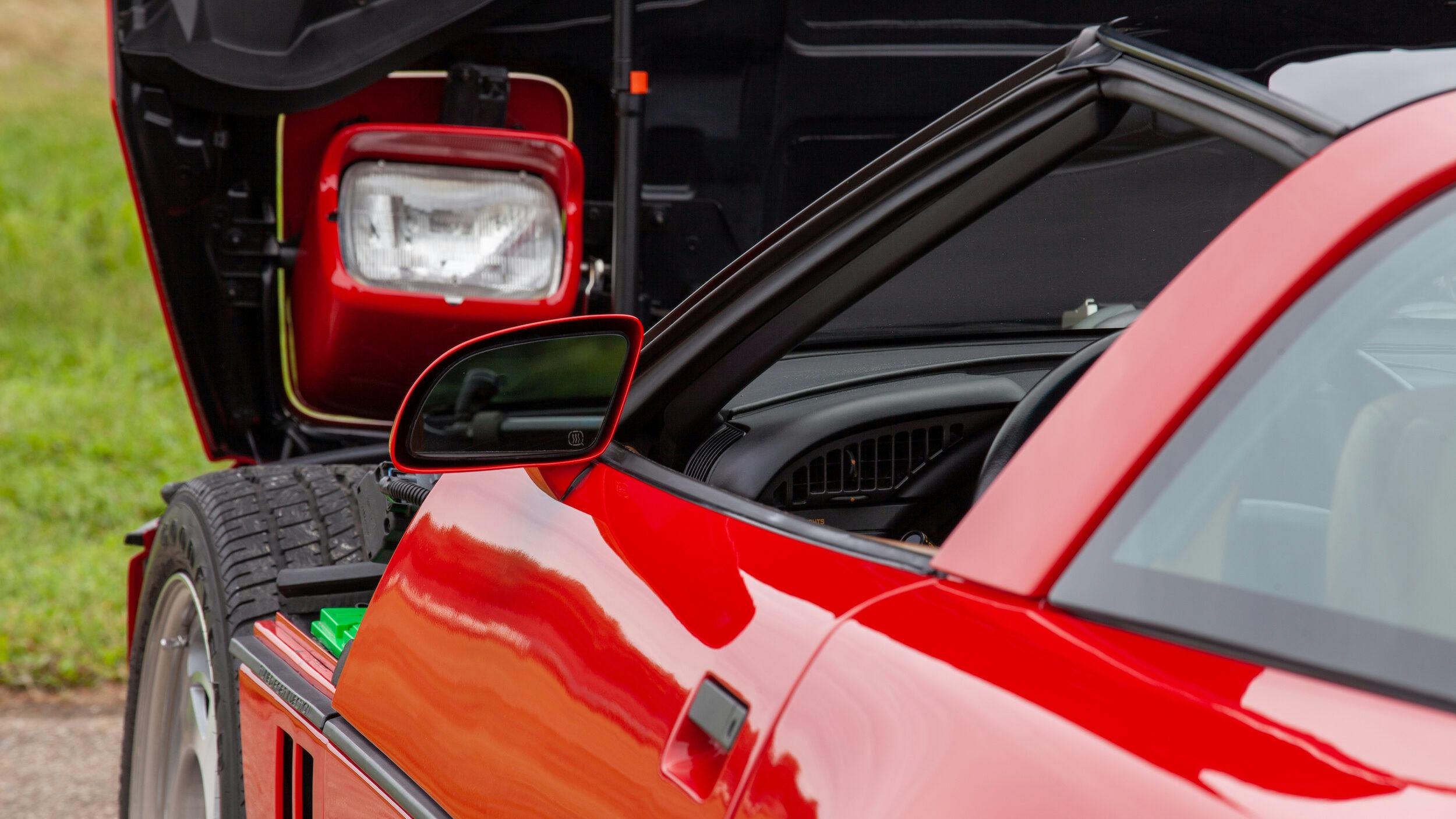
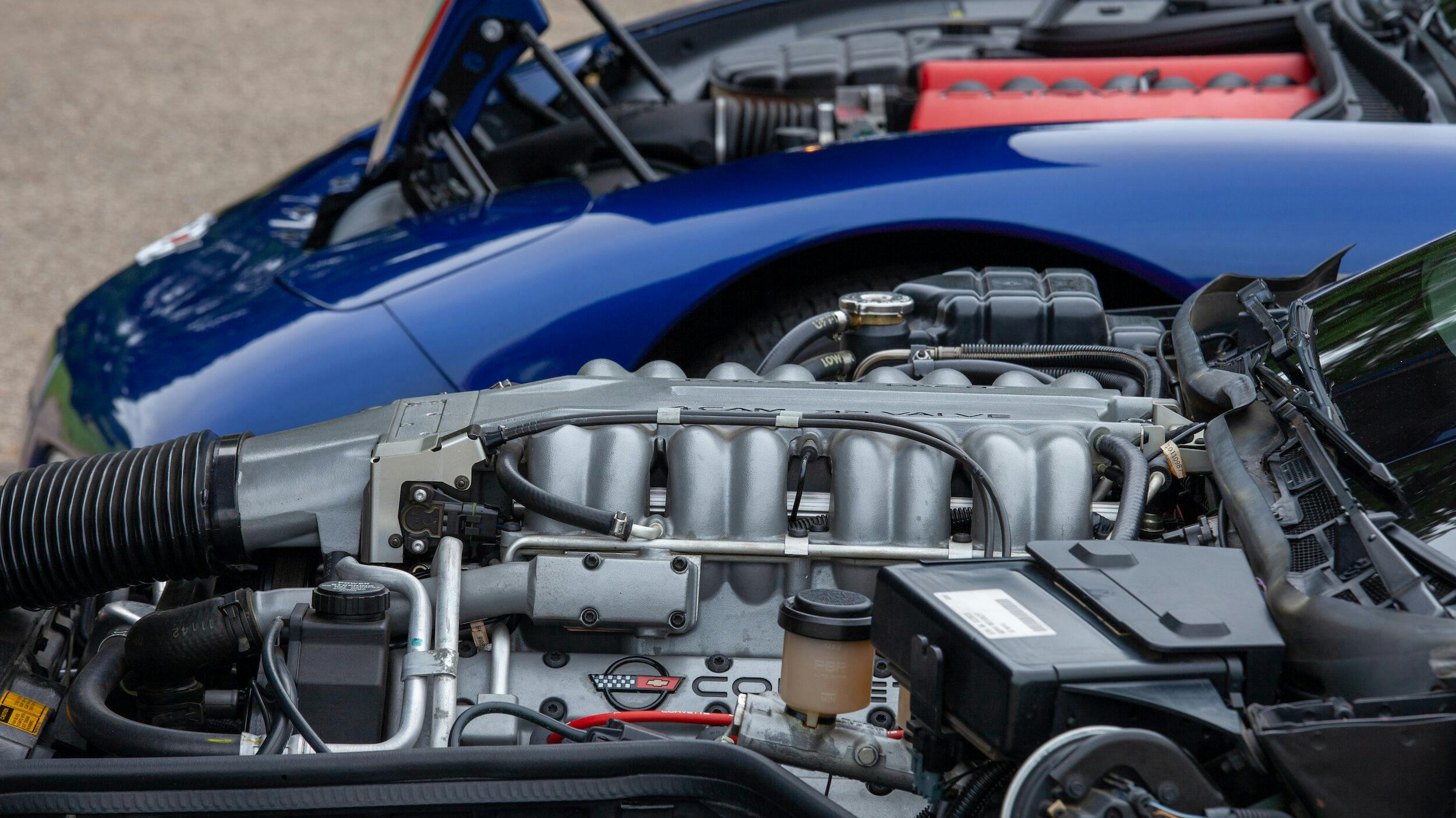
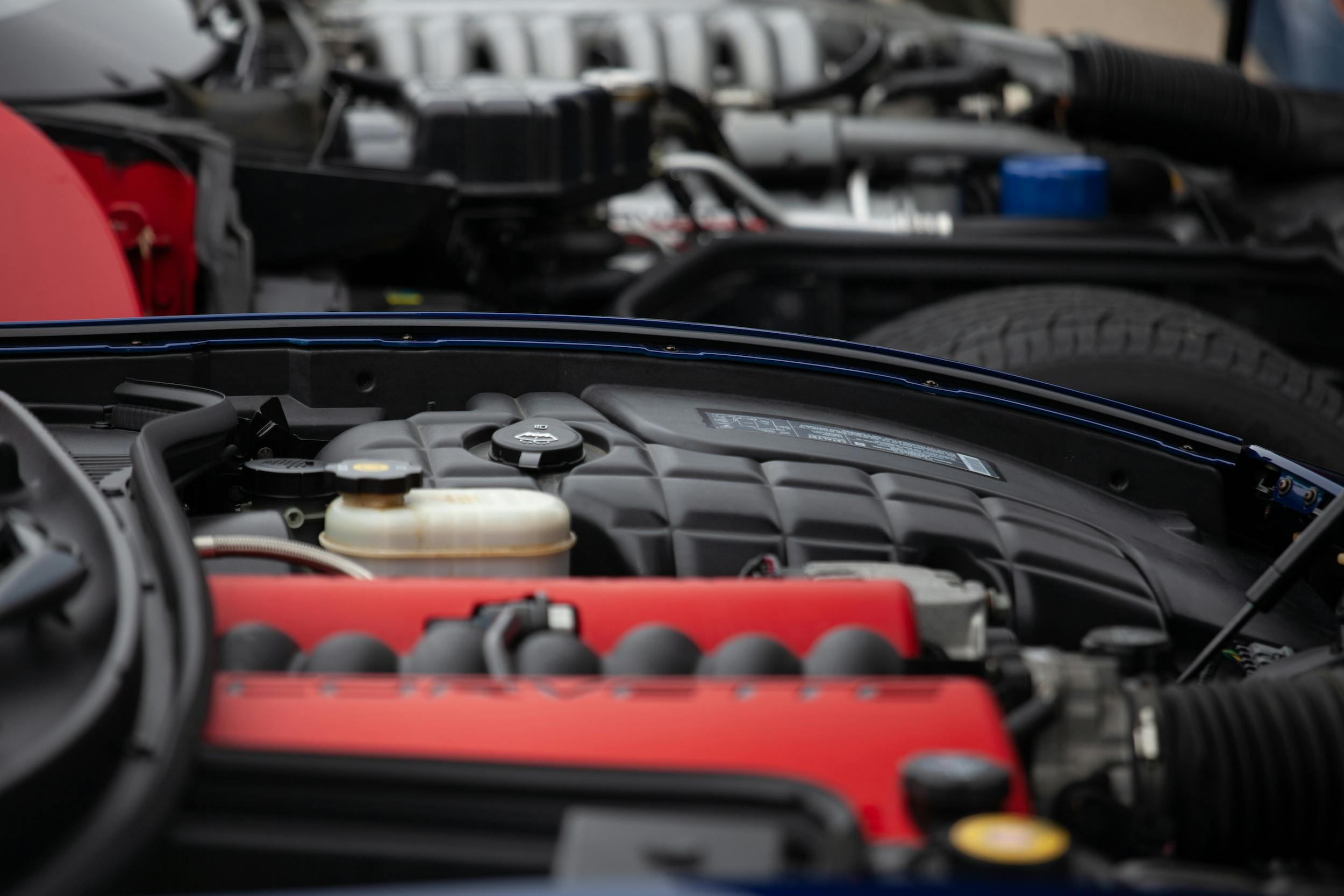
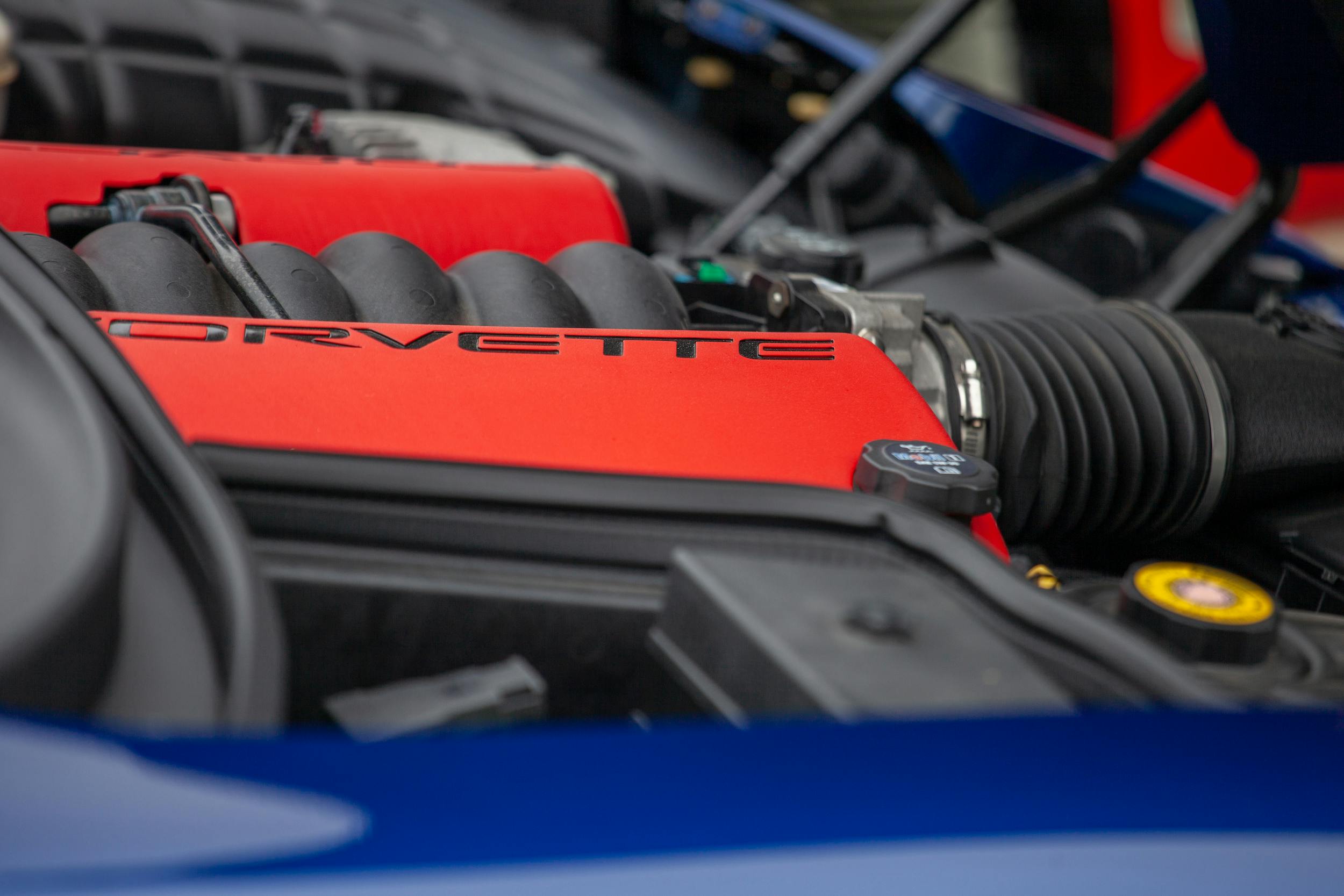
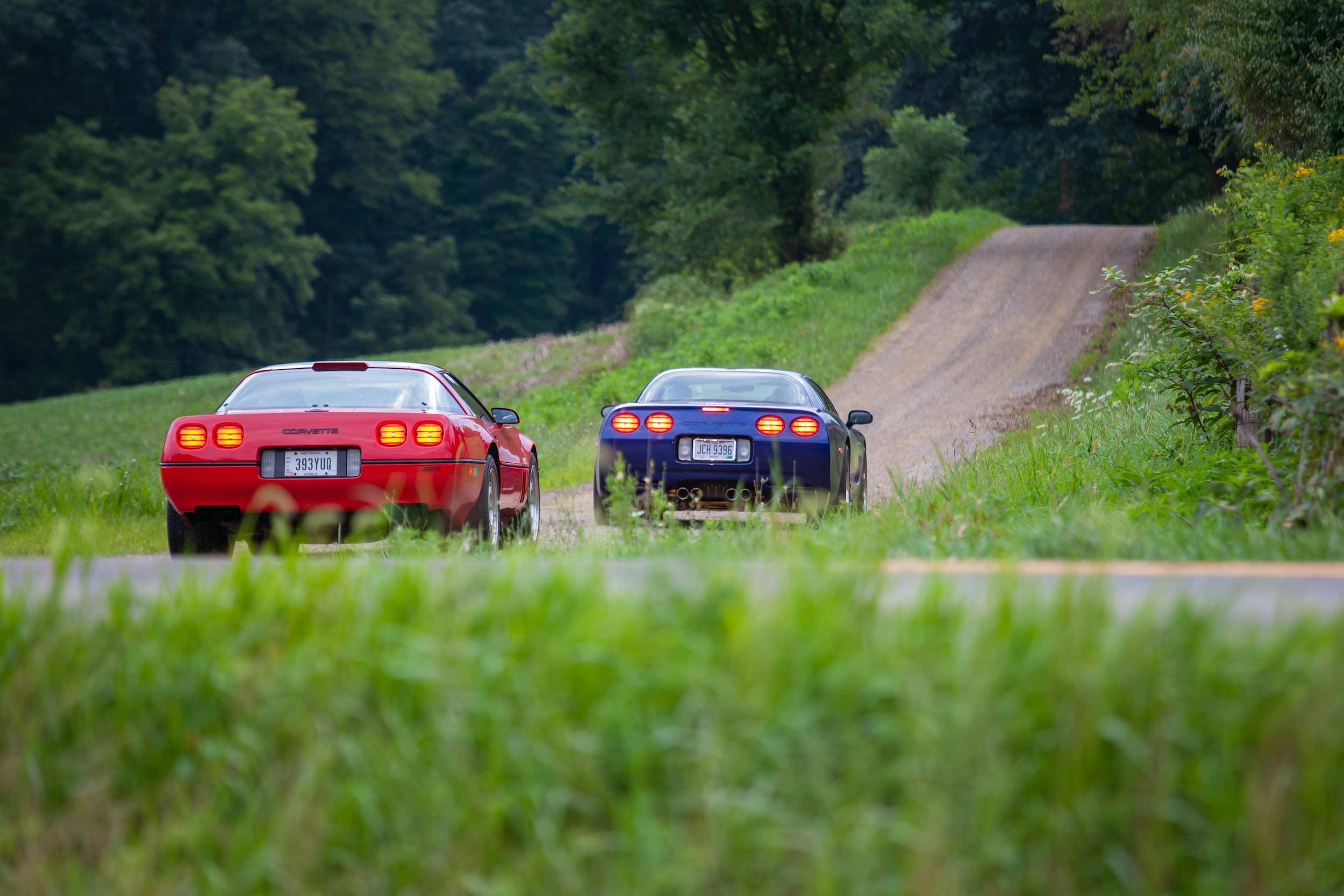

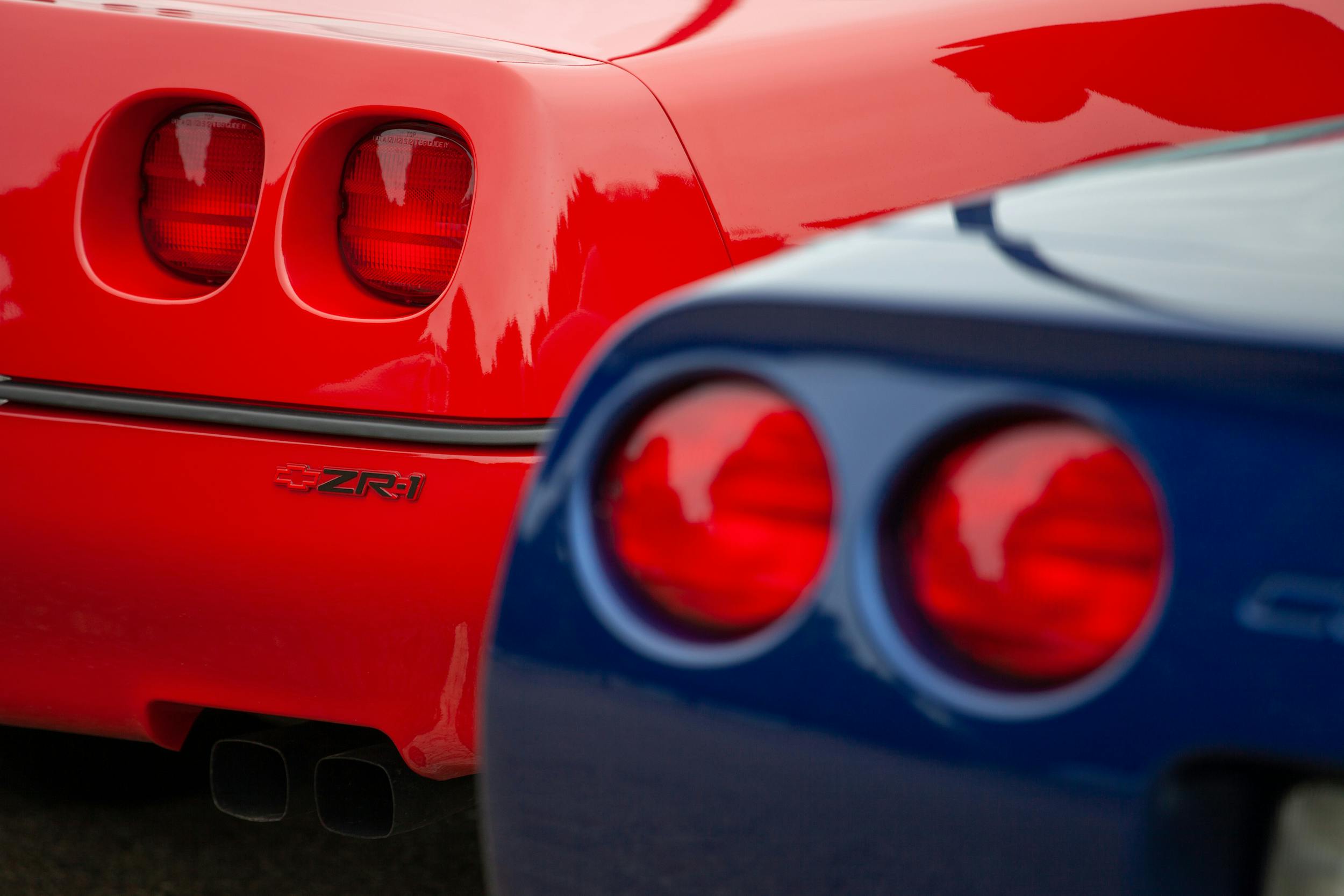
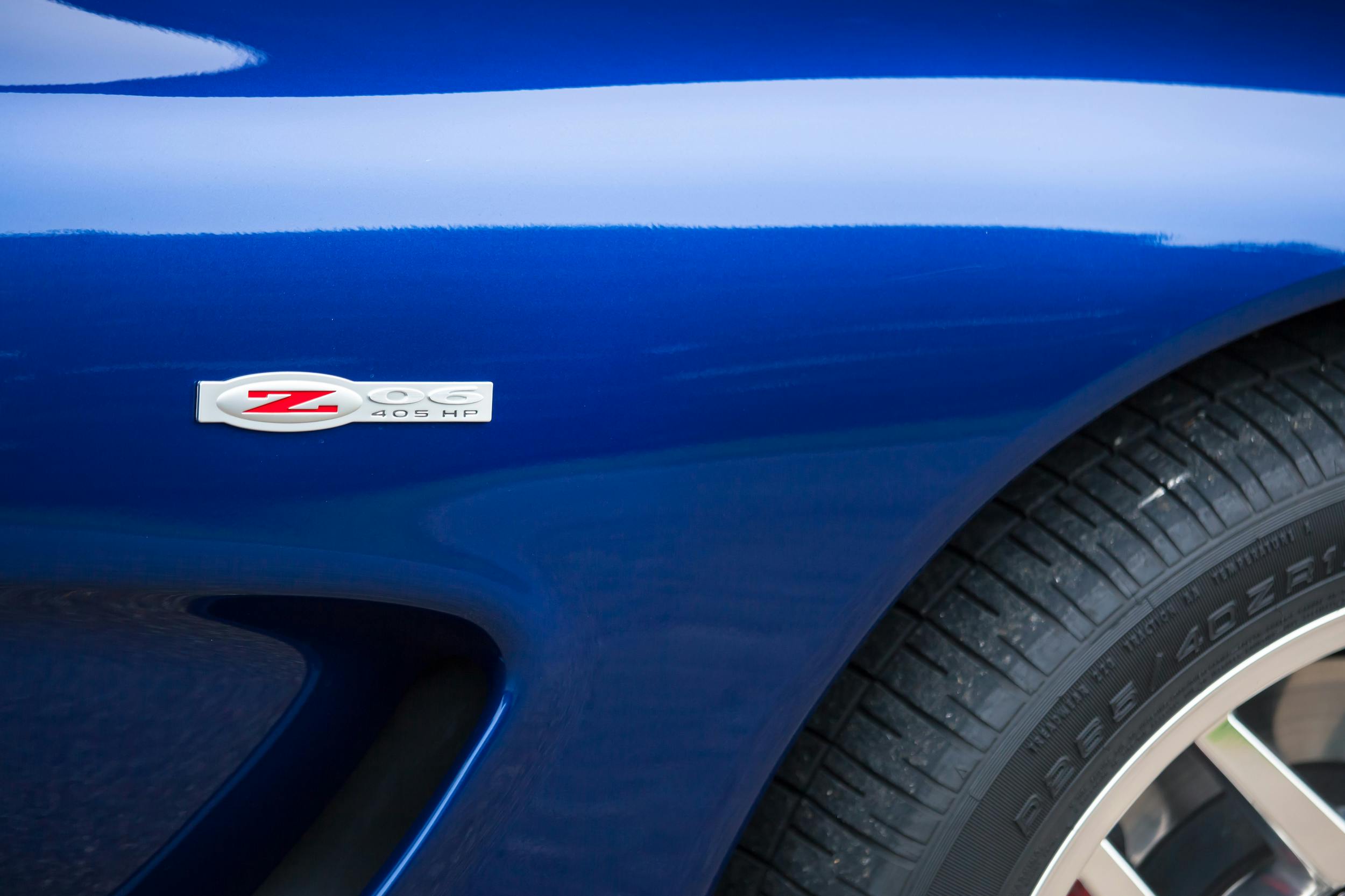



I believe the C4 ZR1 had a 7200 rpm redline not 6500 as stated in the article.
Thanks for pointing that out! The tach’s redline was 7000, not 6500. (As you stated, the actual redline was a bit higher.)
Quarter mile times,0-60,skidpad and braking numbers,would be an interesting compro.
We have a ’96 Corvette Grand Sport and know about the “flex frame” issue…I found the Corvette C4 No Flex Frame Stiffener Bar System for ’86 to ’96 C4’s from Vette2Vette.com. Makes a world of difference and the C4 ride just that much more enjoyable!
There has been an artificial push on the ZR1 for the last couple years.
The Z R1 is interesting but not really that great of a car. It still has the squirrely C4 under an engine that is very difficult to buy parts for. It is not a good investment unless you need to fill a slot in a collection that never goes out. the C5 was a much better car than the ZR will ever be.
Now the Z06 if clean and un molested it will bring good money moving forward. Right not it will bring $10K more than a convertible. They will continue this trend as it was a very good car and it was a limited body. Parts are easy to find and they were very easy to work on.
The C5 in general is the steal on the market right now as so many low mile models and prices under most other cars.
ZR1 was almost never seen on an actual road in its day. Saw 1 in a showroom, one on a road once, and one on a track day running terribly slow with a geriatric doctor trying to find gears. Nobody had one, remembers one, or saw one going fast. The C5 Z06 on the other hand was all of those things in reverse. Love the look, it’s one of the best corvettes ever.
Here are 14 Chicagoland ZR-1’s at Marc Haibeck’s BBQ. Many of them modified, some with over 600hp and they do go fast. One of the most bulletproof engines ever built. https://www.youtube.com/watch?v=GTeNzjpZYF4&t=29s
If I’m not mistaken, when the ZR1 came out in it’s final year (1995?), it was pushing 405 HP also. Only 30 more than the test car here, but still significant. I wonder if you would notice the difference between the first ZR1 and the last ZR1? Fun stuff 🙂
The C4 ZR-1 motor is a thing of beauty. That motor looks so good and revs!
It’s impossible to say anything about a C4 ZR1 without driving one – I can assure the performance is still impressive to this day. And the LT5 noise is something else. With the right and up to date maintenance, these cars can easily break the 150K miles. I love it!
And unlike the Z06, the C4 ZR1 was, and is, something special. The new C8 Z06 is a Ferrari killing NHRA beast. This takes nothing away from the C7 ZR1 (I have one in Torch Red). A new C8 Stingray will beat me 0-60, 0-100, quarter mile. A C8 Z06 doubles down, and sounds as if GM chained demons to twist the axles. But I have the most powerful ‘Vette made by GM, and a clear window in the hood to see where all that noise is from… and when I boot it Jesus Christ will flinch- there’s no reason for “sport exhaust”. It sounds like God’s own hammer, and even though it won’t see the C8Z06’s 8000+ rpm, it has it’s own appeal. And the step off back talk is legendary. Done right, with the stick, I can show 1-2 feet of fire out the exhaust on high rpm lift. And the whine of the blower? Icing. I’m a Luddite. I like my ‘Vettes front engined and overpowered. C8 is great, but not my thing.
Very good information.
I didn’t realize the door sills were lower on the C5 than the C4.
We know that Hagerty wants to insure every Corvette that was ever made, which is why they are incessantly writing articles about them, but in reality very few can afford them, very few have any interest in them, and a good many of us feel the Corvette’s made in the last decade are almost comical looking, like a parody of themselves and to spend the kind of money they demand only to look like a pointy clown burning tons of gas stuck in traffic is why this country is going to hell.
Wow, that is the longest all-negative sentence ever. Take a deep breath and enjoy life.
So Pete, how’s that Prius doing?
Best looking, sounding, handling sports car ever, from the original C1 on.
The only pointy thing here is the top of your head, clown.
Wow…bitter. So, what sports car(s) do YOU favor?
Actually, there is a LOT of interest in Corvettes, if you bother to pay attention. Personally, I have driven a low-mileage 1996 C4, and would have bought it at a very reasonable price (“but in reality very few can afford them”), if not for the fact that I had just bought a different car. C4’s in general continue to be very favorably priced (underpriced, some would say). C5’s may also be, it appears from the article.
I think you nailed it John B. Sheesh!
It is the all American dream to won one, while probably a lot of the parts are made in China.
In other words they are rubbish.
What kinda dumb statement is that? Calling the Corvette rubbish while being ignorant of the facts: https://www.corvetteblogger.com/2020/09/21/report-corvette-ties-for-third-in-the-kogod-made-in-america-auto-index/
Some of the Corvette’s electrical components are Denso, which are high-quality, reliable Japanese stuff, but there were some Euro-made electronic items in earlier (C4) cars that were not as satisfactory reliability-wise, hence the switch to Denso.
Priced the maintenance costs on performance cars from the continent vs Corvettes lately, have you?
Says the guy that undoubtedly drives a 4 door Accord.
My brother in law was a big gun for GM in Oshawa. He tried every Vette they made. He would take them out on the main highway at night when traffic was light. He told me that all would bury the needle easily with lots to spare. He liked to speed so he was always close to losing his licence due to tickets. I’m glad I didn’t pay his insurance!!
I think a hot vette will be whatever the baddest models of the last front engine generation were. Too lazy at the moment to look up the years/ models but a Z06 2020 maybe could be an example. I’m talking about in 2030-ish. Last of the front engine vettes.
No 2020 Z06’s made. That was first year of the C8
I owned a 40th Anniversary ZR-1 (245 produced) for 10 years. Modified it pretty heavily and enjoyed 30,000 trouble free miles with it. May be the best car I have ever owned and I have owned a few (26 Corvettes alone over the past 55 years). For it’s day, it was an engineering marvel.
Soooooo no decision was made. After reading your article we are left shrugging our shoulders. Well done. Here, this is what your article was lacking. A decision. The C5 in both design and technology far surpasses the C4 in almost every way. 1500 less pieces, far more easily removable roof, far better designed retractable headlights, less rattles and creaks. The winner in a decision between the two is obvious. C5. Hands down. You’re welcome, readers.
That’s called progress. It’s also bigger by far in every dimension. The C-4 was leaps and bounds ahead of the C-3. More so then the C-5 from the C-4. Again progress. I will take a C-4 any day of the week over a C-5. The athletic look and dimensions appeal to me more. The C-5 just looks Fat, lol. My Preferance.
Hmmm…not so obvious. The C5 deserves to lose based upon looks alone, with that chubby, fat-reared body, and that ZO6 fixed hardtop.